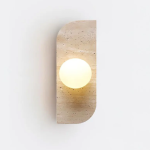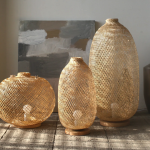
Minimalist design is a philosophy that emphasizes simplicity, functionality, and the elimination of excess. Originating in the mid-20th century, this aesthetic movement has transcended various domains, including architecture, graphic design, and product design. The core principle of minimalism is to strip away the non-essential elements, allowing the essential features to shine through.
This approach not only creates visually appealing objects but also fosters a sense of clarity and tranquility in the spaces they inhabit. In a world increasingly cluttered with distractions and complexities, minimalist design offers a refreshing antidote, promoting a lifestyle that values quality over quantity. The allure of minimalist design lies in its ability to convey elegance through restraint.
It encourages designers to focus on the essence of an object, often leading to innovative solutions that prioritize user experience. In the realm of home decor and functional items, such as hats and desk lamps, minimalism manifests in clean lines, neutral color palettes, and an emphasis on materials that enhance rather than detract from the overall aesthetic. This design philosophy resonates with individuals seeking to create serene environments that reflect their values and aspirations, making it a significant trend in contemporary design.
The Evolution of Hat and Desk Lamp Designs
The evolution of hat designs can be traced back centuries, with each era reflecting the cultural and social dynamics of its time. From the elaborate feathered hats of the 18th century to the sleek baseball caps of today, hats have served various purposes—protection from the elements, fashion statements, and symbols of status. In recent years, minimalist design has influenced hat styles, leading to streamlined silhouettes and functional features that cater to modern lifestyles.
Designers are now focusing on creating hats that are not only stylish but also practical, using lightweight materials and versatile designs that can be easily integrated into everyday wardrobes. Similarly, desk lamps have undergone significant transformations since their inception. Initially designed for functionality, early lamps were often bulky and ornate, reflecting the decorative styles of their time.
However, as the minimalist movement gained traction, designers began to prioritize simplicity and efficiency in lamp design. Contemporary desk lamps often feature geometric shapes, adjustable components, and energy-efficient lighting technologies. This shift towards minimalism has resulted in products that not only illuminate workspaces but also serve as elegant decor pieces that enhance the overall aesthetic of a room.
Innovative Materials and Techniques in Minimalist Design
The pursuit of minimalism has spurred innovation in materials and techniques used in design. In the context of hats, designers are increasingly turning to advanced textiles that offer both functionality and style. For instance, moisture-wicking fabrics and breathable materials are now common in sports hats, ensuring comfort during physical activities while maintaining a sleek appearance.
Additionally, sustainable materials such as organic cotton and recycled polyester are gaining popularity among eco-conscious consumers who appreciate both the aesthetic and ethical dimensions of their purchases. In desk lamp design, the use of cutting-edge materials has led to remarkable advancements in both form and function. For example, aluminum and high-quality plastics are frequently employed for their lightweight yet durable properties.
These materials allow for intricate designs that would be impossible with traditional metals or glass. Furthermore, techniques such as 3D printing have revolutionized lamp production, enabling designers to create complex shapes with precision while minimizing waste. This innovative approach not only enhances the visual appeal of desk lamps but also aligns with the minimalist ethos of efficiency and sustainability.
Functionality and Aesthetics in Minimalist Hat and Desk Lamp Designs
In minimalist design, functionality is paramount; every element must serve a purpose while contributing to the overall aesthetic. This principle is particularly evident in modern hat designs, where practicality meets style. For instance, many contemporary hats incorporate features such as adjustable straps for a customizable fit or built-in UV protection for sun safety.
These functional aspects do not compromise the hat’s visual appeal; instead, they enhance it by demonstrating thoughtful design that caters to the needs of the wearer. Desk lamps exemplify this balance between functionality and aesthetics as well. The best minimalist lamps are designed with user experience in mind, offering adjustable brightness levels or flexible arms that allow for precise positioning of light.
The aesthetic appeal is achieved through clean lines and harmonious proportions that make these lamps suitable for various interior styles. A well-designed desk lamp can serve as a focal point in a room while providing essential lighting for tasks such as reading or working on a computer. This duality—where form meets function—embodies the essence of minimalist design.
The Influence of Technology on Minimalist Design
Technology has played a pivotal role in shaping minimalist design across various domains, including hats and desk lamps. In hat design, advancements in fabric technology have led to the creation of lightweight materials that offer superior performance without sacrificing style. For example, moisture-wicking fabrics keep wearers comfortable during outdoor activities while maintaining a sleek silhouette.
Additionally, smart textiles equipped with sensors can provide real-time data on temperature or UV exposure, merging fashion with functionality in innovative ways. In the realm of desk lamps, technology has revolutionized lighting solutions through the integration of LED technology and smart features. LED lights are not only energy-efficient but also allow for sleek designs due to their compact size.
Many modern desk lamps now come equipped with smart capabilities, enabling users to control brightness levels or color temperatures via smartphone apps or voice commands. This intersection of technology and minimalist design results in products that are not only visually appealing but also enhance user convenience and adaptability in an ever-evolving digital landscape.
Sustainability and Eco-Friendly Practices in Minimalist Design
Sustainability has become an integral aspect of minimalist design as consumers increasingly prioritize eco-friendly practices in their purchasing decisions. In hat design, brands are exploring sustainable materials such as organic cotton, hemp, and recycled plastics to create stylish yet environmentally responsible products. These materials not only reduce environmental impact but also resonate with consumers who value ethical production methods.
Furthermore, many designers are adopting practices such as local sourcing and fair labor standards to ensure that their products align with sustainable principles. Desk lamp manufacturers are also embracing sustainability by focusing on energy-efficient lighting solutions and recyclable materials. The shift towards LED technology has significantly reduced energy consumption compared to traditional incandescent bulbs, making desk lamps more eco-friendly options for consumers.
Additionally, some brands are implementing take-back programs that encourage customers to return old lamps for recycling or repurposing. This commitment to sustainability reflects a broader trend within minimalist design—creating products that not only serve their intended purpose but also contribute positively to the environment.
Minimalist Design in Contemporary Home and Office Spaces
Minimalist design has found its way into contemporary home and office spaces, transforming how individuals interact with their environments. In residential settings, minimalist principles promote open spaces filled with natural light and uncluttered surfaces. Furniture pieces are often chosen for their functionality and aesthetic appeal, creating harmonious living areas that foster relaxation and creativity.
Hats designed with minimalist aesthetics can complement these spaces by adding subtle touches of style without overwhelming the overall decor. In office environments, minimalist design enhances productivity by reducing distractions and promoting focus. Desks equipped with sleek desk lamps provide optimal lighting conditions while maintaining a clean look that aligns with minimalist principles.
The integration of multifunctional furniture—such as desks with built-in storage—further exemplifies this approach by maximizing space efficiency without compromising on style. As more individuals embrace remote work or flexible office arrangements, minimalist design continues to shape how we create functional yet aesthetically pleasing workspaces.
The Future of Minimalist Hat and Desk Lamp Designs
Looking ahead, the future of minimalist hat and desk lamp designs appears promising as designers continue to explore new materials, technologies, and concepts that align with minimalist principles. In hat design, we may see further innovations in smart textiles that offer enhanced functionality while maintaining a stylish appearance. For instance, hats equipped with built-in headphones or Bluetooth connectivity could redefine how we experience fashion accessories in our daily lives.
In the realm of desk lamps, advancements in smart home technology will likely influence future designs. As homes become increasingly interconnected through IoT devices, desk lamps may evolve into multifunctional hubs that integrate seamlessly with other smart devices for enhanced user experience. The emphasis on sustainability will continue to drive innovation as designers seek eco-friendly materials and production methods that resonate with environmentally conscious consumers.
As minimalism continues to evolve within the context of contemporary design trends, it remains rooted in its core principles: simplicity, functionality, and an unwavering commitment to quality over quantity. The future promises exciting developments that will further enrich our understanding of minimalist design while enhancing our everyday experiences with thoughtfully crafted products like hats and desk lamps.



